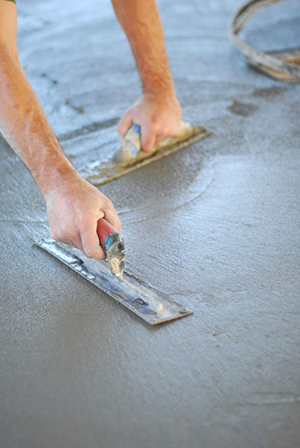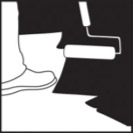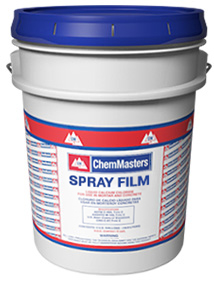Seal the Deal is intended to be an informative and educational publication for ChemMasters’ network of independent manufacturer’s representatives, distributors and contractors. We don’t want to make you chemical engineers, but we do want to help you feel better informed and more comfortable discussing construction chemicals. If there are specific products or topics you would like to see addressed in a future issue, please contact
John Fauth.
Using Evaporation Retarders
Anyone who has placed and finished concrete understands the prevailing environmental conditions can be a real problem. Cold weather will retard the set of concrete, and may prevent it from curing at all. It may require the use of wind breaks, indirect heating and curing blankets
in order to properly place and finish concrete under cold weather conditions (refer to ACI 306R-10 "Guide to Cold Weather Concreting").

Spray Film will inhibit moisture loss prior to final finish of concrete, dry shake hardeners, and repair mortars.
Similarly, hot weather concreting provides its own challenges. Elevated temperatures, direct sunlight, low humidity, air movement… many summer environmental conditions can draw water out of fresh concrete, causing it to become stiff or prematurely set, making it difficult to place
and/or finish. Although it’s tempting to replace the lost water by adding more water, doing so will change the water to cement ratio (particularly at the surface), detracting from the concrete’s engineered properties, strength and durability.
Good hot weather concreting practices (refer to ACI 305R-10 "Guide to Hot Weather Concreting") may include various methods to cool concrete, the use of specialized admixtures and aggregates in the mix design, adherence to proper curing techniques, and the use of a monomolecular
film. Often referred to as "evaporation retarders", monomolecular films are applied to the surface of freshly placed concrete to inhibit moisture loss prior to finishing. Unlike the addition of water, proper use of evaporation retarders will not change the water to cement ratio
and do not detract from concrete’s engineered properties, strength and durability.
Use of ChemMasters’ Spray Film™ evaporation retarder will effectively reduce moisture loss in windy conditions by 80%, and 40% in direct sunlight. Spray Film will reduce plastic shrinkage cracking, wind crusting, and does not interfere with the adhesion of curing and sealing
products.
Every contractor has had some concrete "get away" from them due to premature moisture loss. It becomes sticky, is prone to "tearing" and difficult to finish. Make it a practice to keep an evaporation retarder like Spray Film with your equipment and supplies, ready for use whenever
environmental conditions demand.
Do's
- Spray Film is supplied in a highly concentrated formula that is diluted one (1) to nine (9) with clean, potable water.
- Evaporation retarders are best applied directly to the bleed water, or when bleed water would normally be present. In severe conditions, Spray Film may be reapplied.
- Evaporation retarders may be applied to fresh concrete, and many dry shake hardeners and patching mortars, including all those manufactured by ChemMasters.
Don'ts
- Never apply an evaporation retarder to hardened concrete, as staining may occur.
- Evaporation retarders are not curing compounds, and should not be used to cure concrete.
- Only apply evaporation retarders as a light mist… do not over apply or allow to puddle.
Color enhancing treatment for architectural pavers
Paver Enhancer enhances and enriches color development of architectual pavers, and improves stain resistance.
Seal the Deal is intended to be an informative and educational publication for ChemMasters’ network of independent manufacturer’s representatives, distributors and contractors. We don’t want to make you chemical engineers, but we do want to help you feel better informed and more comfortable discussing construction chemicals. If there are specific products or topics you would like to see addressed in a future issue, please contact
John Fauth.

 Seal the Deal
Seal the Deal


